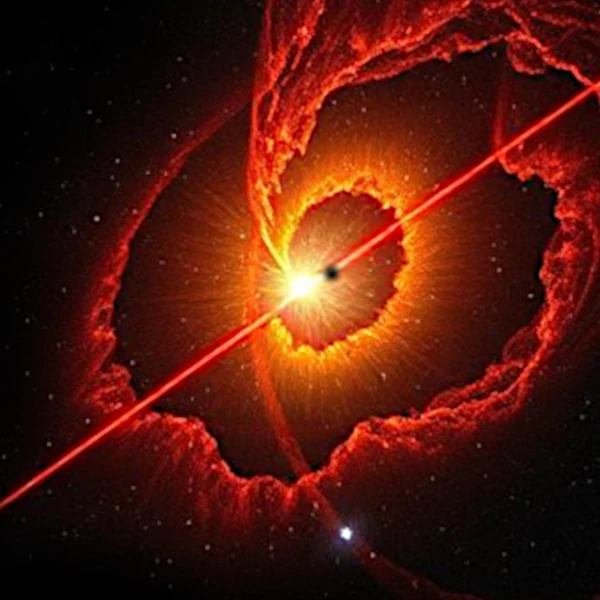
Quasars (for "quasi-stellar radio source") are among the brightest and most energetic objects in the known Universe. Discovered in the early 1960s by Maarten Schmidt (1929-2022), they emit radiation capable of rivaling the light of hundreds of entire galaxies. Their power comes from accretion onto a supermassive black hole located at the center of an active galaxy.
A quasar is neither a simple black hole nor a galaxy. It represents a state of activity of the galactic nucleus, not a separate type of object. The quasar refers to the extreme activity phenomenon observed at the center of certain galaxies, not the material object itself.
The black hole is the energy engine, the quasar the observable phenomenon produced by this engine, and the host galaxy the gravitational framework containing the entire system.
The total luminosity of a quasar can reach \( L \approx 10^{40}\ \mathrm{W} \), about \(10^{13}\) times that of the Sun. Such energy can only originate from an efficient gravitational mechanism. Mass-energy conversion follows the relativistic equation \(\,E = \eta m c^2\,\), where \(\eta\) is the efficiency, typically between 0.1 and 0.4 in a relativistic accretion disk.
Note:
An active galaxy has an extremely bright nucleus powered by accretion of gas onto a supermassive black hole. This energy, around \(10^{39}\) to \(10^{41}\ \mathrm{W}\), described by \(\,E = \eta m c^2\,\) with \(\eta \approx 0.1\), makes AGN the most powerful sources in the observable Universe.
Quasars are at cosmological distances, sometimes over 12 billion light-years away. Their spectra show high redshift (\(z > 6\)), indicating emission when the Universe was only a fraction of its current age.
These measurements allow astrophysicists to study the epoch of cosmic reionization, the transition of the Universe from a neutral to an ionized state. Quasars, illuminating the intergalactic medium, serve as temporal beacons of cosmic structure formation.
| Quasar | Redshift (z) | Approx. Distance (billion ly) | Comment |
|---|---|---|---|
| 3C 273 | 0.158 | 2.2 | Relatively nearby quasar, well studied |
| PG 1302-102 | 0.278 | 3.5 | Quasar with suspected periodic variability |
| QSO B0909+532 | 2.00 | 10.2 | Moderate redshift quasar for spectral studies |
| Quasar B1422+231 | 3.62 | 11.6 | High redshift, used for gravitational lens studies |
| SDSS J1250+3130 | 4.10 | 12.0 | Distant quasar observed by the Sloan Digital Sky Survey |
| SDSS J1021+2803 | 5.05 | 12.5 | High-redshift quasar, witness of the young Universe |
| SDSS J0100+2802 | 6.30 | 12.8 | One of the most distant known quasars |
| ULAS J1120+0641 | 7.08 | 12.9 | Epoch of cosmic reionization |
Around the central black hole, matter forms a rapidly rotating disk. Internal friction converts gravitational potential energy into electromagnetic radiation.
Strong magnetic fields channel part of the energy into relativistic jets, capable of propelling particles at speeds near \(c\), the speed of light. These jets, observed notably by the VLBA, are a major signature of Active Galactic Nuclei (AGN).
Observations suggest most massive galaxies host a supermassive black hole at their center. Quasars may represent a transitional phase in this galactic evolution: when a gas inflow triggers rapid accretion, the nucleus becomes dazzling. Once the matter reservoir is depleted, the galaxy stabilizes and the quasar shuts down.
The observed correlation between black hole mass (\(M_{\mathrm{BH}}\)) and galactic bulge mass (\(M_{\mathrm{bulge}}\)) suggests coevolution governed by energetic feedback: \( M_{\mathrm{BH}} \propto M_{\mathrm{bulge}}^{1.1} \)
| Object Type | Typical Luminosity (W) | Observed Distance | Dominant Characteristic |
|---|---|---|---|
| Quasar | 1039 to 1041 | > 1 billion ly | Extremely luminous across the spectrum, high redshift, powerful relativistic jets, witnesses of early galactic formation |
| Blazar | 1038 to 1040 | Up to 5 billion ly | Relativistic jet pointed toward Earth, rapid variability, intense gamma-ray and X-ray emission |
| Seyfert galaxy | 1036 to 1038 | < 200 million ly | Strong optical and UV emission lines, moderate active nucleus, host stars visible |
| Radio galaxy | 1037 to 1040 | Hundreds of millions to several billion ly | Dominant radio emission, extended lobes over hundreds of kpc, relativistic jets, often obscured nucleus |
| LINER | 1035 to 1037 | Often < 100 million ly | Low ionization, moderate nuclear emission, often in elliptical or mature spiral galaxies |
| Obscured AGN / Type 2 | 1036 to 1039 | Variable depending on galaxy | Central radiation blocked by a dust torus, hidden nucleus, emission mostly in IR and X-rays |
Source: NASA ADS Astrophysics Data System, European Southern Observatory (ESO).